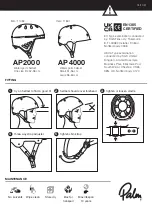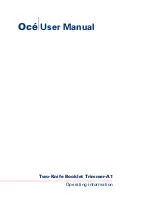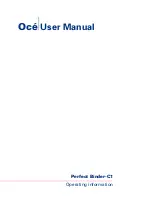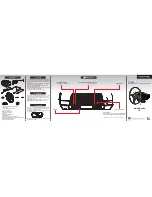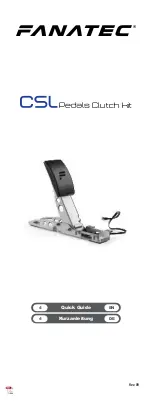
12
B-CONTROL
AUDIO
BCA2000
LINE STEREO is selected and both insert connectors are in use,
only the right (LINE R) signal in the stereo input channel will be
processed via insert B. Insert A works only on the mono input
channel and is not affected by the position of the LINE STEREO
button. +48 V phantom power is available for the microphone
inputs.
The signals of both input channels are mixed together into a
stereo input sum and fed into the two-channel A/D converter.
Before this, the input sum signal can be processed by the internal
dynamics processing section of your B-CONTROL. In this case,
the signal first goes to the noise gate and then to the limiter
(which effectively protects the A/D converter from clipping).
Digital inputs:
The digital inputs are available as optical and coaxial
connectors. Both S/PDIF and AES/EBU formats are supported.
The optical input also accepts signals in ADAT
®
format.
Four-channel 24-bit/96 kHz operation with ADAT
®
S/MUX is also
possible. Use the DIGITAL IN button
to select the digital input
source. The selection is displayed in the audio routing diagram
on the top of your BCA2000.
If an ADAT
®
or an ADAT
®
S/MUX signal is connected to the
optical input, it is automatically recognized and activated, and the
red LED in the audio routing diagram illuminates. In this case, the
analog inputs are deactivated.
Combination of analog and digital inputs:
The High-Speed USB connection transmits a maximum of eight
input channels. This can either be an eight-channel ADAT
®
signal
or a combination of digital and analog input signals. Due to the
BCA2000s input architecture, these are the input sum signal
and a two-channel digital input signal. This signal can either
come from the optical or the coaxial input, and can be selected
using the DIGITAL IN switch
. The digital format (AES/EBU or
S/PDIF) is selected in the control panel software. If an
ADAT
®
S/MUX stream is transmitted, a maximum of four channels
at 24 bit/96 kHz is available. The following table provides an
overview of the possible combinations:
86%
,Q
1R$'$7
,Q6LJQDO
$'$7
,Q6LJQDO
N+]
$'$7
608;
,Q6LJQDO
N+]
1
Analog In Sum L
ADAT In 1
S/MUX In 1
2
Analog In Sum R
ADAT In 2
S/MUX In 2
3
Digital In L
2
ADAT In 3
S/MUX In 3
4
Digital In R
2
ADAT In 4
S/MUX In 4
5
-
ADAT In 5
-
6
-
ADAT In 6
-
7
-
ADAT In 7
-
8
-
ADAT In 8
-
1
Analog In Sum L
ADAT In 1
-
2
Analog In Sum R
ADAT In 2
-
3
Digital In L
2
ADAT In 3
-
4
Digital In R
2
ADAT In 4
-
High-Speed Mode (480 Mbit/s)
Full-Speed Mode (12 Mbit/s)
1) Optical digital input must be selected. Analog In Sum (input
sum) muted.
2) Optical or coaxial digital input selectable. Format selection
(AES/EBU or S/PDIF) via control panel software.
Table 4.2: Input routing
+
In Full-Speed USB operation, the USB interface can
only transmit 4 audio channels. Transmitting audio
signals with a sampling rate of 96 kHz is not
possible!
4.2 Output routing
On the output side, eight channels can also be transmitted via
(High-Speed) USB. Various combinations of analog and digital
outputs are available for playback.
The stereo input sum signal for USB transmission is created in
the mixer of your audio software. This signal is fed digitally
through the optical
and coaxial
outputs. The same
signal is also available on the main analog outputs. Additionally,
there are four analog RCA outputs that can be used for playing
back subgroups, monitor mixes or surround signals.
Use the OPTICAL OUT button
to select a digital format for
the optical output: ADAT or 2-CHANNEL.
4.2.1 Output routing in ADAT mode
In ADAT
®
mode (OPTICAL OUT button not pressed), eight
channels can be played back in ADAT
®
format via the optical
output. The eight-channel signal is also available on the analog
outputs; signal/output assignments are shown in table 4.3. Use
the CH. 1-2/CH. 7-8 button
to assign a signal source to the
coaxial output: either USB channel 1-2 or 7-8. The transmission
of 96-kHz signals is done per sample multiplexing via the ADAT
®
output.
86%
2XW
$QDORJ
&RD[LDO
$'$7
N+]
$'$7
608;
N+]
1
Main Out 1/L
Digital L
1
ADAT Out 1
S/MUX Out 1
2
Main Out 2/R Digital R
1
ADAT Out 2
S/MUX Out 2
3
Analog Out 3
-
ADAT Out 3
S/MUX Out 3
4
Analog Out 4
-
ADAT Out 4
S/MUX Out 4
5
Analog Out 5
-
ADAT Out 5
-
6
Analog Out 6
-
ADAT Out 6
-
7
-
Digital L
1
ADAT Out 7
-
8
-
Digital R
1
ADAT Out 8
-
Main Out 1/L
ADAT Out 1
Analog Out 5
ADAT Out 5
Main Out 2/R
ADAT Out 2
Analog Out 6
ADAT Out 6
ADAT Out 3
ADAT Out 7
ADAT Out 4
ADAT Out 8
3
4
Analog Out 3
Digital L
2
-
-
Digital R
2
Analog Out 4
High-Speed Mode (480 Mbit/s)
Full-Speed Mode (12 Mbit/s)
1) Sw itchable betw een USB Outs 1-2 and USB Outs 7-8
(High-Speed Mode) via button 23. Format selection (AES/EBU
or S/PDIF) via control panel software.
2) Switchable betw een USB Outs 1-2 and USB Outs 3-4 (Full-
Speed Mode) via button 23. Format selection (AES/EBU or
S/PDIF) via control panel software.
1
2
Digital L
2
Digital R
2
-
-
Table 4.3: Output routing in ADAT
®
mode
In
Full-Speed USB
operation, only 4 signals are transmitted
per USB, and there is no support for 96 kHz operation. The digital
coaxial output always carries one stereo signal selectable with
the CH. 1-2/CH. 7-8 button
: when set to CH. 1-2, USB
channels 1 and 2 (Main Out Signal) are transmitted; when set to
CH. 7-8, USB channels 3 and 4 are transmitted. These signals
are simultaneously fed to analog outputs 3 and 4. On the ADAT
®
output, the four USB channels are doubly occupied to transmit
the eight ADAT channels (see table 4.3).
4. AUDIO ROUTING

























